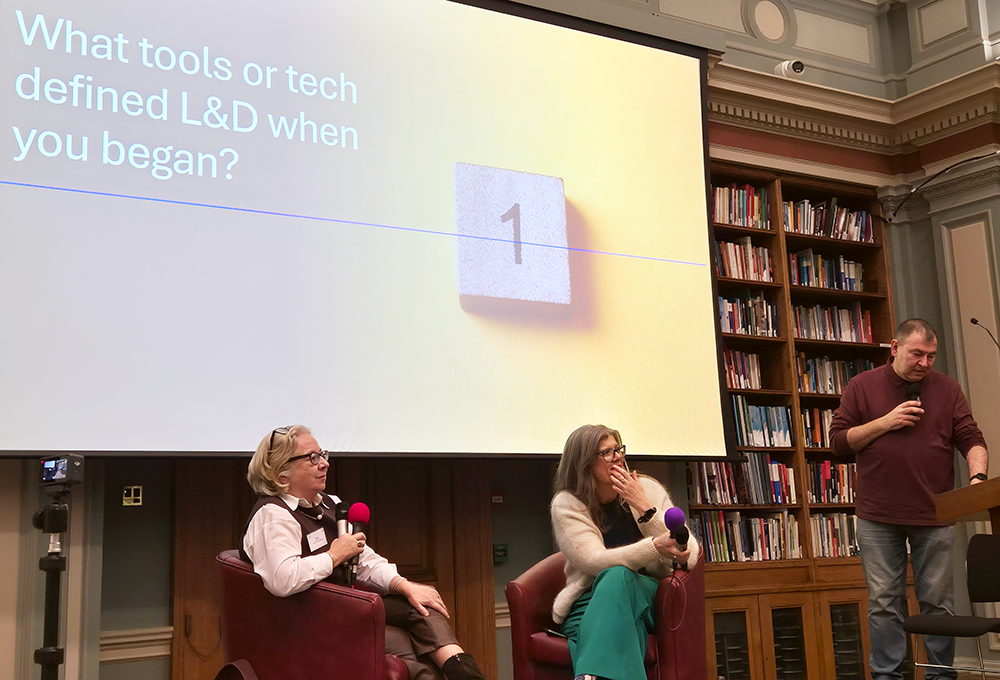Stephanie Garforth suggests four key steps to make the most of ‘brilliant, but challenging’ talent.
Disruptive talent will always ask very different questions and look at things from a different perspective. Photo credit: Fotolia
Disruptive talent is a new term being used in business to describe individuals who are brilliant, but challenging. In the past they may have been side-lined, but now they are being recognised for their potential to revolutionise the firms in which they work through delivering significant growth to the bottom line of major UK businesses and generating new income streams.
More Features
How to establish a culture of growth and development
However, identifying, integrating and then managing disruptive talent within a business can prove to be challenging. In order to justify disruptive talent programmes in businesses, big questions need to be asked. Why should businesses start looking at disruptive talent?
How do businesses know that they’re ready for disruptive talent? How do they identify the right disruptive talent? And how do they manage and integrate disruptive talent in the business?
Leveraging disruptive talent
It’s easy to assume that high performers will be the ones to create value in the business. However, when organisations are chasing the latest ‘big idea’ to be one step ahead of competitors, a different kind of talent is required. The majority of people are wired to fit in, to follow norms, maintain harmony and not take risks. However, to drive a radical kind of change requires the remarkable minds of those labelled as disruptive talent.
While ‘disruptive’ and ‘talent’ are two words that historically have not been connected, these particular individuals have unique perspectives of the world that prompt them to think outside the box and act differently, provocatively challenge conventional wisdom and practice to adopt new approaches, and see commercial opportunities unseen to others. When placed in the right supportive environment, they will relentlessly and tenaciously find new and better ways to deliver business success.
The multitude of positive features that disruptive talent brings can sometimes be missed by the organisations whose alarm bells ring at the first signs of disruptive behaviour. It is even likely that these individuals are the ones that organisations seek to get rid of in a quick attempt to maintain harmony. It is therefore vital to distinguish disruptive talent from delinquents.
Disruptive talent are not loose cannons that scatter gunfire to intentionally cause mayhem in every direction. Instead they are the mavericks with a mission, an intense focus and an insatiable drive to create something. They are quirky and creative, and disrupt conformity, desired behaviour and rulebooks, but understand which boundaries are important and do not traverse them unknowingly. They are the ones with the potential to drive business in a new direction if welcomed, encouraged and supported well.
As Sir Richard Branson suggests, if organisations could look after, respect and accept disruptive talent like him, then they will have gained a creative force to drive innovation rather than losing a competing entrepreneur who seeks to work against them.
There are three key contexts where conventional talent alone would take too long to propel the business forward:
- Generating revenue in a new area where the approach required is different to the existing norms
- Organic growth where creativity is required that will challenge conventional wisdom with suggestions that may be labelled as insane
- Acquisition growth where the organisation is currently unable to spot opportunities because their radar is too restricted. In these situations the ability to find reasons not to go into a new market overrides any calibration of the opportunity in the new market with personal preservation being at the core.
Evaluate the risks
While disruptive talent has the potential to develop game-changing business ideas, they can be a challenge to work with and integrate within the organisation. The characteristics that give them their strength can also be the source of their unproductive or derailing behaviours.
For example, a senior manager who loves to challenge the status quo is likely to be intolerant of the more accommodating approaches of others and may berate colleagues or refuse to co-operate with them. The single-minded focus that helps a brilliant engineer solve complex problems, might also make them oblivious to the needs and differing learning styles of their co-workers, acting in ways that may frustrate and upset them.
In essence, disruptive talent is likely to behave in ways that cause interruptions that take them off-track and negatively impact on others, which can be destructive to the organisation. Indeed many organisations get it wrong by bringing in disruptive talent to ‘shake things up’, but without putting in place the necessary support.
These individuals become too challenging and too disruptive, leading to negative rather than positive business impacts. However, the fact that these risks exist should not dissuade an organisation from employing disruptive talent, but it is crucial for organisations to be able to recognise the challenges and then anticipate and take action to minimise the risks.
Added to these complexities are the differing motivations of disruptive talent. When disruptive talent finds themselves part of a large organisation, they struggle to fit within the corporate structure and boundaries.
The freedom and flexibility they value dissipates and they can feel frustrated by the routines and what they perceive as narrow-minded thinking. They can feel that they are being shut down by laborious procedures and pressures to conform. This can lead to hostility and bitterness and these valuable individuals may feel compelled to leave, leading to the exit of their innovations as well.
For example, the gifted designer who feels enlivened by new challenges, might quickly get bored by the bureaucratic obstacles she or he continuously encounters and take their talents elsewhere. Organisations that wish to benefit from the extraordinary talent that such people can bring, must learn how to manage them in a way that reduces the risks of derailing. They must first be ready for change and create a supportive environment in which disruptive talent can succeed.
Recruit the right talent
Assessing disruptive talent is somewhat more complex than assessing traditional talent. With traditional assessment approaches, disruptive talent is often the ‘outliers’ (see Figure 1, below) as their overall assessment performance does not necessarily reflect their potential impact.
In the right context and at the right point in time they could have a disproportionately powerful impact on the organisation. But at the wrong time and wrong place, they may not last one year or they become institutionalised and lose what they could have brought to the organisation.
Rigorous assessment processes can help identify disruptive talent during recruitment and in existing staff. This blends psychometric profiling with in-depth interviewing and exercises to assess the potential of disruptive talent and understand how to land the individual effectively.
Such assessments look at the whole life of the individual along with personality profiles to understand their approach in detail. This includes exercises, case studies and simulations that allow traditional talent to generate the textbook approach and disruptive talent to come up with something off-centre that may just be a game changer.
Often, destructive and derailing behaviours are more likely to be exhibited during stressful periods when an individual’s ability to self-monitor and self-regulate is diminished. For this reason use particular psychometrics that bring to light how such people are likely to perform under various conditions, verifying findings through in-depth interviews that look at what motivates them and their past performance.
Based on the findings from the extensive assessment process recommendations can be made about whether the risks associated with an individual should deter an organisation from taking them on, or whether this person will just need to be managed in the right way. The decision needs to be informed by the following considerations:
- What level of disruption is the organisation prepared to take?
- How prepared are people in the business for disruption?
- What degree of protection and support is the organisation willing to give the disruptive talent?
- What degree of protection is the organisation willing to give the core business that most likely will be impacted by the disruption?
Developing performance
In contrast to traditional talent, the conditions have to be right for disruptive talent to succeed because these individuals will not adapt and fit into the status quo.
Creating the right conditions is not easy as there is no single way to manage disruptive talent effectively and prevent them from derailing. As suggested above, there are a range of reasons why disruptive talent might pose a risk to an organisation. It is therefore crucial that the approach organisations take managing and developing these individuals address individual needs and are formulated on a case-by-case basis.
The way in which organisations should be supported to innovate through disruptive talent is by offering tailored and integrated programmes to ensure that these individuals are supported in the right environment with the right approach, and that their derailers are anticipated and managed effectively. Working with HR departments and managers can help to provide the disruptive talent with the opportunity to build their leadership competence in a safe environment. This will maximise their chances of success.
Individual effectiveness
One strand of this typically involves providing individual support through coaching to help address the differing risks to maximise personal effectiveness. Disruptive talent will always ask very different questions, look at things from a different perspective and are persistent at achieving the outcomes they want. Coaching is a key mechanism for keeping such individuals focussed on the right things and ensuring their potentially negative impact on others is managed.
Creating individual development plans based on the results of the assessment process will be helpful at covering goals and identifying foreseeable obstacles that could impede their success. This will provide managers of the disruptive talent with line of sight of the objectives to support and monitor progress and also provide them with the capability to manage these individuals in the most effective way.
Team environment
Another strand of this typically involves ensuring the right team composition in terms of capability, skills and personality. Disruptive talent, for example, passionately and tenaciously pursue unconventional thinking, which could benefit from action oriented ‘doers’ to tether them down from running away with ideas.
In consideration of the characteristics of disruptive talent, organisations should carefully position colleagues around them who are conventional enough to challenge their ideas, but unconventional enough to collaborate with them. This deliberate act of putting together teams of people who think and behave differently from each other can cause the team dynamics to derail effectiveness. To ensure success, it is important to provide team support and development to ensure working relationships are close, transparent and developmental.
Cultural environment
Leaders set the direction, style and tone for the organisation and condone and reinforce patterns of acceptable behaviour. Therefore, the third strand involves working with the leadership to foster an environment that harnesses the collective power of disruptive talent and their teams.
A start-up environment is not the same as a traditional corporate environment and great ideas don’t necessarily happen in meeting rooms during working hours. Leaders need to reinforce cross-collaboration and create opportunities for external experiences to encourage individuals to think differently and ambitiously.
Rather than pressurising disruptive talent to conform or force them to operate within the tight parameters of the traditional corporate environment, leaders must enforce a culture of trust, openness and space where individuals are valued for who they are and comfortable to express their views to allow them to respond authentically.
To this end, leaders and managers should be supported through developmental workshops to clarify their vision and accountabilities, alter their behaviours to help them lead by example and support their communications process to quickly and effectively establish changes to the existing ways of working. This promotes flexibility, energy, ideas and acceptance of ‘risky’ pursuits outside of traditional norms. Strong leadership direction is particularly important when times get tough as the gut reaction is to deliver more with less. The effect is often greater levels of control, micro-management and condemnation of initiative taking, which is counter-productive for disruptive talent.
Summary
Running a disruptive talent programme can be a huge commitment, but also a huge commercial opportunity for an organisation. For it to succeed, it is important that the organisations do the following:
- Identify the right talent
- Establish the right conditions and boundaries around which disruptive talent can develop business opportunities
- Provide appropriate support to encourage the right supportive culture and behaviours
- Ensure that the organisation is ready to sustain the disruption
- Ensure that you have a top team with the right level of ambition and imagination to create the opportunity for disruptive talent to flourish.
About the author
Stephanie Garforth is a consultant at OE Cam, a group of business psychologists and consultants who help to maximise the effectives of individuals, teams and organisations.



